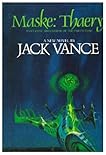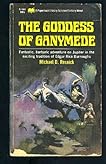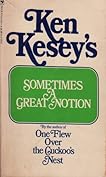 Hadon of Ancient Opar by Philip José Farmer
Hadon of Ancient Opar by Philip José FarmerMy rating: 5 of 5 stars
Originally published at http://www.fantasyliterature.com/revi...
To most general readers of science fiction, Philip Jose Farmer is probably best known as the creator of the RIVERWORLD series, and possibly also as the Golden Age writer who brought sex into the Science Fiction scene through his stories “The Lover” (1952) and Flesh (1960). He also loved to dabble in other author’s created universes, to the extent that he wrote numerous pastiches and fictional “biographies” purportedly by and about such characters as Edgar Rice Burroughs’ TARZAN, Kurt Vonnegut’s KILGORE TROUT, and DOC SAVAGE, just to name a few. Fans of Burroughs’ Tarzan books will probably remember that the erudite “ape-man” visited a lost city known as Opar in several of the books, a last remnant of an ancient civilization, possibly Atlantis. The denizens of Opar are ruled by a beautiful Queen named La, who is high priestess of the Oparians and falls in love with Tarzan in The Return of Tarzan, the second book in the series. Since Tarzan is already in love with Jane Porter of Virginia (not Great Britain, as in the Johnny Weissmuller movies), the love of La is not requited, but the two have a mutual attraction and relationship that persists throughout the series in several of the novels.
In the 1970’s Farmer wrote a novel set in the prehistory of Burroughs’ Opar, entitled Hadon of Ancient Opar (1974) which was to be the beginning of a series. The eponymous hero of the novel is Hadon, a young warrior from Opar sent to represent his city at the Great Khokarsan Games, a sort of Olympic Games set to choose a new King every generation. At the time of the novel, roughly 12,000 years ago, Opar is actually a smaller less important city in the empire of Khokarsa, a civilization set in various cities around the shores of, and also on a large island in, a huge inland sea in the middle of the African continent. The kingdom or empire is matriarchal, with a Queen/High Priestess ruling the land, but also with a King/High Priest who controls the military. The ruling deity is Kho, a fertility Goddess whose female priestesses control all non-military aspects of society, while the male deity is Resu, god of the sun, whose male priests are subservient to the rule of Kho and her priestesses. At the time the novel begins however, there is a struggle going on between the patriarchal followers of Resu and the matriarchal followers of Kho.
Farmer has a lot of fun with the set-up of the history of the Khokarsan ancestors of the later day Oparians Tarzan will later encounter. He drags all kinds of literary antecedents and historical anachronisms into his novel, including homages to H. Rider Haggard’s ALLAN QUATERMAIN series, especially the novel Allan and the Ice Gods (1927) and also some possible links to Haggard’s other memorable character Ayesha of She: A History of Adventure (1987). There is also a mysterious off-stage character mentioned throughout the story, a seemingly immortal tall grey-eyed wanderer known as Sahhindar, possibly the god of Time, or possibly a human being who has discovered the secrets of time travel and long life. Sahhindar is responsible for having introduced the Khokarsans to many of their advancements in agriculture and military science over the preceding centuries, allowing them to achieve a Bronze Age culture while being surrounded by Stone Age neighbors. Astute readers of the book may deduce who this Sahhindar really is.
The premise of the novel is that the winner of the games will become King, if the Queen decides to accept him. She has the option of refusing to do so, however. Young Hadon does indeed win the games, but before he can become King he is sent on a quest to find a mysterious woman with violet colored eyes who was seen by a previous expedition of Khokarsans in the far north and who is under the protection of the even more mysterious aforementioned Sahhindar. At the point where Hadon and a group of warriors and priestesses set out for the legendary northern sea, the action truly picks up and Farmer is at his best.
Hadon of Ancient Opar is a fun read, and it is especially so for die-hard fans of Burroughs, but it may be a little confusing for those readers who aren’t familiar with the Tarzan books. Editor Christopher Paul Carey has written a forward to this Titan Books reissue of the novel, along with appendices of dates, maps and glossaries for this edition that help explain the tie-ins and context of the story. I enjoyed re-reading this novel almost forty years after the first time I read it, but there are a few things that I noticed this second time around that escaped me initially. There are parts of the novel where the anachronisms seem a little over the top, especially early on in the book when the contestants are competing in the games to determine who will be king. As just one example, I wish Farmer had taken time to call his running events something different than the “100-yd. dash” and the “2 mile run” as the modern terminology grates a little. While the society is matriarchal, with women priestesses being in charge both in relationships and government in the villages and cities Hadon and his group pass through, the essential passiveness of a couple of the major female characters may be off-putting to some readers. There is also a fair amount of blood and gore and an alleged off stage rape of a high priestess, resulting in the exile of a character who makes an appearance late in the book.
I recommend Hadon of Ancient Opar to anyone who’s a fan of Burroughs, and Haggard however. I also recommend it to anyone interested in reading up on Farmer’s diverse oeuvre and learning about his various forays into the works and creations of other authors. There are several related novels and stories in this series, including a direct sequel Flight to Opar (1976), and a couple of related stories started by Farmer and finished by Carey in The Song of Kwasin (2012). (These are all collected in Subterranean Press’s recent omnibus edition.) There is also a novella entitled “Kwasin and the Bear God” and Farmer’s time travel novel Time’s Last Gift (1972) can be considered a sort of prequel to the series as well.
View all my reviews




















